Experimental Research on Manson–Coffin Curves for the Frame Material of an Unconventional Vehicle
Abstract
:1. Introduction to Problem Statement
2. Materials and Methods
3. Results
4. Discussion
5. Conclusions
- The fatigue curve of the basic material for the Brown–Miller model under cyclic loading is lower in the whole range of the cycle numbers. In the case of the given material, the method of its loading and the weld design, the results suggest that the Brown–Miller model can serve as a substitute for this experiment (Figure 8, Figure 9, Figure 10, Figure 11, Figure 12, Figure 13, Figure 14, Figure 15, Figure 16, Figure 17, Figure 18 and Figure 19);
- Fatigue of specimens responds more sensitively to a small change in the deformation amplitude in comparison with torsion;
- Software developers in this specific field can use obtained data to expand the material database;
Author Contributions
Funding
Institutional Review Board Statement
Informed Consent Statement
Data Availability Statement
Conflicts of Interest
Nomenclature
| TIG | Non-melting tungsten electrode welding in the inert gas atmosphere |
| 1F2R | Delta layout for three-track vehicle |
| Mo | Bending moment |
| MoF | Bending moment from the engine of experimental mechanism |
| MoB | Reaction bending moment in the experimental specimen holder |
| D | Diameter of specimen out of the tensile concentrator area |
| do | The smallest diameter of the specimen in the area of tensile concentrator |
| dy | General diameter (variable in length) of the specimen in the tensile concentrator area |
| x | Horizontal axis of the coordinate system |
| y | Vertical axis of the coordinate system |
| s | Distance of the curvature center of the circle needed to form the specimen tensile concentrator from the horizontal axis (x) |
| l | Specific length of tensile concentrator for the specimen |
| R | The radius of circle curvature needed to form the tensile concentrator of the specimen |
| R2 | Coefficient of regression model determination |
| RA | Supportive reaction in connection point A |
| RB | Supportive reaction in connection point B |
| Tensile energy (internal energy) | |
| Ε | Modulus of elasticity in tension |
| Nf | Number of cycles to fracture |
| γac | Amplitude of total deformation in shear |
| Wo | Bending cross-sectional modulus |
| Jz | Moment of inertia |
| SWT | Fatigue criterion according to Smith, Watson and Topper |
| F-S | Fatigue criterion according to Fatemi–Socie |
| LIU | Fatigue criterion according to Liu |
| B-M | Fatigue criterion according to Brown–Miller |
| εac | Amplitude of total bending deformation |
| φ | Phase shift of load |
| σxx | Bending stress (normal) |
| τxy | Torsional stress (tangential) |
References
- Ataei, M.; Khajepour, A.; Jeon, S. Reconfigurable Integrated Stability Control for Four- and Three-wheeled Urban Vehicles with Flexible Combinations of Actuation Systems. IEEE-ASME Trans. Mechatron. 2018, 23, 2031–2041. [Google Scholar] [CrossRef]
- Sumarsono, D.A.; Jati, M.K.; Muiz, M.A. Modelling of Tilting and Steering Control System for a Tadpole Three-Wheeled Vehicle. In Proceedings of the 4th International Conference on Mechanical, Aeronautical and Automotive Engineering ICMAA 2020, Bangkok, Thailand, 26–29 February 2020. [Google Scholar]
- Ataei, M.; Khajepour, A.; Jeon, S. Rollover stabilities of three-wheeled vehicles including road configuration effects. Proc. Inst. Mech. Eng. Part D—J. Automob. Eng. 2017, 231, 859–871. [Google Scholar] [CrossRef]
- Jin, Z.L.; Weng, J.S.; Hu, H.Y. Rollover stability of a vehicle during critical driving manoeuvers. Proc. Inst. Mech. Eng. Part D—J. Automob. Eng. 2007, 221, 1041–1049. [Google Scholar] [CrossRef]
- Sindha, J.; Chakraborty, B.; Chakravarty, D. Rigid body modeling of three-wheel vehicle to determine the dynamic stability—A practical approach. In Proceedings of the IEEE International Transportation Electrification Conference ITEC, Chennai, India, 27–29 August 2015. [Google Scholar]
- Gerlici, J.; Sakhno, V.; Yefymenko, A.; Verbitskii, V.; Kravchenko, A.; Kravchenko, K. The stability analysis of two-wheeled vehicle model. In Proceedings of the 22th Slovak-Polish Scientific Conference on Machine Modelling and Simulations 2017 (MMS 2017), Sklene Teplice, Slovakia, 05–08 September 2017. [Google Scholar]
- Jeong, K.; Choi, S. Road Bank Angle Estimation for Three Wheel Tilting Vehicle Using Multi Model Estimator. In Proceedings of the 2nd International Conference on Mechanical, Aeronautical and Automotive Engineering ICMAA 2018, Singapore, 24–26 February 2018. [Google Scholar]
- Berote, J.; Darling, J.; Plummer, A. Development of a tilt control method for a narrow-track three-wheeled vehicle. Proc. Inst. Mech. Eng. Part D—J. Automob. Eng. 2012, 226, 48–69. [Google Scholar] [CrossRef] [Green Version]
- Antony, J.J.; Jayabal, K. Rollover Dynamics of a Narrow Tilting Three-Wheeled Vehicle. In Proceedings of the International Conference on Mechanical, Manufacturing, Modeling and Mechantronics IC4M 2016, Kuala Lumpur, Malaysia, 27–29 February 2016. [Google Scholar]
- Tan, J.T.C.; Arakawa, H.; Suda, Y. Steering Dynamics of Tilting Narrow Track Vehicle with Passive Front Wheel Design. In Proceedings of the 13th International Conference on Motion and Vibration Control (MOVIC 2016) and the 12th International Conference on Recent Advanced in Structural Dynamics (RASD 2016), Southampton, UK, 3–6 July 2016. [Google Scholar]
- Blatnický, M.; Sága, M.; Dižo, J.; Bruna, M. Application of Light Metal Alloy EN AW 6063 to Vehicle Frame Construction with an Innovated Steering Mechanism. Materials 2020, 13, 817. [Google Scholar] [CrossRef] [Green Version]
- Ewanochko, T.W.; Eng, P.; Nelson, D.; Eng, P.; Esaki, M.T.; Pesheck, E. Integrated Durability Analysis Using ANSYS, ADAMS and Finite Element Fatigue. In Proceedings of the 15th ADAMS European User’s Conference, Rome, Italy, 15–17 November 2000. [Google Scholar]
- Ogarevic, V.V.; Aldred, J. An Implementation of Low-cycle Multiaxial Fatigue Methods. In Proceedings of the European Conference on Computational Mechanics ECCM-2001, Cracow, Poland, 26–29 June 2001. [Google Scholar]
- Opala, M.; Korzeb, J.; Koziak, S.; Melnik, R. Evaluation of stress and fatigue of a rail vehicle suspension component. Energies 2021, 14, 3410. [Google Scholar] [CrossRef]
- Sága, M.; Blatnický, M.; Vaško, M.; Dižo, J.; Kopas, P.; Gerlici, J. Experimental Determination of the Manson-Coffin Curves for an Original Unconventional Vehicle Frame. Materials 2020, 13, 4675. [Google Scholar] [CrossRef] [PubMed]
- Wang, W.; Song, Y. Analytical computation method for steady-state stochastic response of a time-delay non-linear automotive suspension system. Mech. Syst. Signal Process. 2019, 131, 434–445. [Google Scholar] [CrossRef]
- Hassen, D.B.; Miladi, M.; Abbes, M.S.; Baslamisli, S.C.; Chaari, F.; Haddar, M. Road profile estimation using the dynamic responses of the full vehicle model. Appl. Acoust. 2019, 147, 87–99. [Google Scholar] [CrossRef]
- Neslušan, M.; Trško, L.; Minárik, P.; Čapek, J.; Bronček, J.; Pastorek, F.; Čížek, J.; Moravec, J. Non-Destructive Evaluation of Steel Surfaces after Severe Plastic Deformation via the Barkhausen Noise Technique. Metals 2018, 8, 1029. [Google Scholar] [CrossRef] [Green Version]
- Lago, J.; Trško, L.; Jambor, M.; Nový, F.; Bokůvka, O.; Mičian, M.; Pastorek, F. Fatigue Life Improvement of the High Strength Steel Welded Joints by Ultrasonic Impact Peening. Metals 2019, 9, 619. [Google Scholar] [CrossRef] [Green Version]
- Derakhashan, E.D.; Yazdian, N.; Craft, B.; Smith, S.; Kovacevic, R. Numerical simulation and experimental validation of residual stress and welding distortion induced by laser-based welding processes of thin structural steel plates in butt joint configuration. Opt. Laser Technol. 2018, 104, 170–182. [Google Scholar] [CrossRef]
- Chen, Q.; Yang, J.; Liu, X.; Tang, J.; Huang, B. Effect of the Groove type when considering a thermometallurgical-mechanical model of the welding residual stress and deformation in an S355JR-316L dissimilar welded joint. J. Manuf. Processes 2019, 45, 290–303. [Google Scholar] [CrossRef]
- Jakubovicova, L.; Sapietova, A.; Moravec, J. Static analysis of transmission tower beam structure. In Proceedings of the 3rd International Scientific Conference on Innovative Technologies in Engineering Production ITEP, Bojnice, Slovakia, 11–13 September 2018. [Google Scholar]
- Pastričák, R.; Ščury, J.; Moravec, J. The effects of pressure during the crystallization on properties of the alsi12 alloy. Arch. Foundry Eng. 2017, 17, 103–106. [Google Scholar] [CrossRef] [Green Version]
- Sága, M.; Blatnická, M.; Blatnický, M.; Dižo, J.; Gerlici, J. Research of the Fatigue Life ofWelded Joints of High Strength Steel S960 QL Created Using Laser and Electron Beams. Materials 2020, 13, 2539. [Google Scholar] [CrossRef] [PubMed]
- Caban, J.; Nieoczym, A.; Gardzński, L. Strength analysis of a container semi-truck frame. Eng. Fail. Anal. 2021, 127, 105487. [Google Scholar] [CrossRef]
- Rudawska, A.; Miturska, I.; Szebelski, J.; Skoczylas, A.; Droździel, P.; Bociąga, E.; Madleňák, R.; Kasparek, D. Experimental research and statistic analysis of polymer composite adhesive joints strength. J. Phys. Conf. Ser. 2017, 842, 012074. [Google Scholar] [CrossRef]
- Gerlici, J.; Shvedchikova, I.A.; Nikitchenko, I.V.; Romanchenko, J.A. Investigation of influence of separator magnetic system configuration with permanent magnets on magnetic fields distribution in working area. Electr. Eng. Electromech. 2017, 2, 13–17. [Google Scholar] [CrossRef]
- Bazhinov, O.; Gerlici, J.; Kravchenko, O.; Haiek, Y.; Bazhynova, T.; Zaverukha, R.; Kravchenko, K. Development of a method for evaluating the technical condition of a car’s hybrid powertrain. Symmetry 2021, 13, 2356. [Google Scholar] [CrossRef]
- Dobrodenka, P.; Dobrodenka, A.; Gerlici, J.; Lack, T.; Blatnický, M.; Harušinec, J.; Dižo, J.; Kurčík, P.; Suchánek, A.; Strážovec, P. A Steering Suspension of a Front Wheel of a Three-Track Vehicle. Patent Y1 8603, 11 September 2019. (In Slovak). [Google Scholar]
- Moreno-Ramirez, C.; Tomas-Rodriguez, M.; Evangelou, S.A. Dynamic analysis of double wishbone front suspension systems on sport motorcycles. Nonlinear Dyn. 2018, 91, 2347–2368. [Google Scholar] [CrossRef]
- Marconi, E.; Massar, M. The Effect of Suspensions and Racetrack Three-Dimensionality on the Minimum Lap Time of Motorcycles. In Proceedings of the 26th Symposium of the International Association of Vehicle System Dynamics IAVSD 2019, Gothenburg, Sweden, 12–16 August 2020. [Google Scholar]
- Moreno-Ramírez, C.; García-Fernández, P.; de-Juan, A.; Tomas-Rodríguez, M. Interconnected suspension system on sport motorcycles. Mech. Mach. Sci. 2014, 17, 9–16. [Google Scholar]
- Moreno-Ramírez, C.; Tomas-Rodríguez, M. Non linear optimization of a sport motorcycle’s suspension interconnection system. In Proceedings of the 10th UKACC International Conference on Control, Loughborough, UK, 09–11 July 2014. [Google Scholar]
- Dižo, J.; Blatnický, M.; Saga, M.; Harušinec, J.; Gerlici, J.; Legutko, S. Development of a New System for Attaching the Wheels of the Front Axle in the Cross-Country Vehicle. Symmetry 2020, 12, 1156. [Google Scholar] [CrossRef]
- Benedetti, M.; Fontanari, V.; Santus, C.; Bandini, M. Notch fatigue behaviour of shot peened high-strength aluminium alloys: Experiments and predictions using a critical distance method. Int. J. Fatigue 2010, 32, 1600–1611. [Google Scholar] [CrossRef]
- Böhm, M.; Kowalski, M. Fatigue life estimation of explosive cladded transition joints with the use of the spectral method for the case of a random sea state. Mar. Struct. 2020, 17, 102739. [Google Scholar] [CrossRef]
- eFatigue: Fatigue Analysis on the Web. Available online: https://www.efatigue.com/ (accessed on 1 October 2021).
- Cetin Morris, S. Influence of Material Ductility on Fatigue Life under Multiaxial Proportional and Non-Proportional Normal and Shear Stresses. In Proceedings of the MATEC Web of Conferences, Sibiu, Romania, 5–7 June 2019; Volume 300. [Google Scholar]
- Karolczuk, A.; Papuga, J. Thierry Palin-L. Progress in fatigue life calculation by implementing life-dependent material parameters in multiaxial fatigue criteria. Int. J. Fatigue 2020, 134, 105509. [Google Scholar] [CrossRef]
- Sharifimehr, S.; Fatemi, A. Interaction Between Normal and Shear Stresses and Its Effect on Multiaxial Fatigue Behavior. In Proceedings of the MATEC Web of Conferences, Sibiu, Romania, 5–7 June 2019; Volume 300. [Google Scholar]
- Curiel, F.F.; Ambriz, R.R.; Garcia, M.A.; Ramirez, M.C.; Garcia, S. Smith Watson and Topper Model in the Determination of the Fatigue Life of an Automotive Steel. In International Conference on New Trends in Fatigue and Fracture, Proceedings of the 17th International Conference on New Trends in Fatigue and Fracture, Cancun, Mexico, 25–27 October 2017; Springer International Publishing: New York, NY, USA, 2018. [Google Scholar]
- Lambertsen, S.H.; Damkilde, L.; Kristensen A., S.; Pedersen, R.R. Estimation of Fatigue Life of Laser Welded AISI304 Stainless Steel T-Joint Based on Experiments and Recommendations in Design Codes. World J. Mech. 2013, 3, 32623. [Google Scholar] [CrossRef] [Green Version]


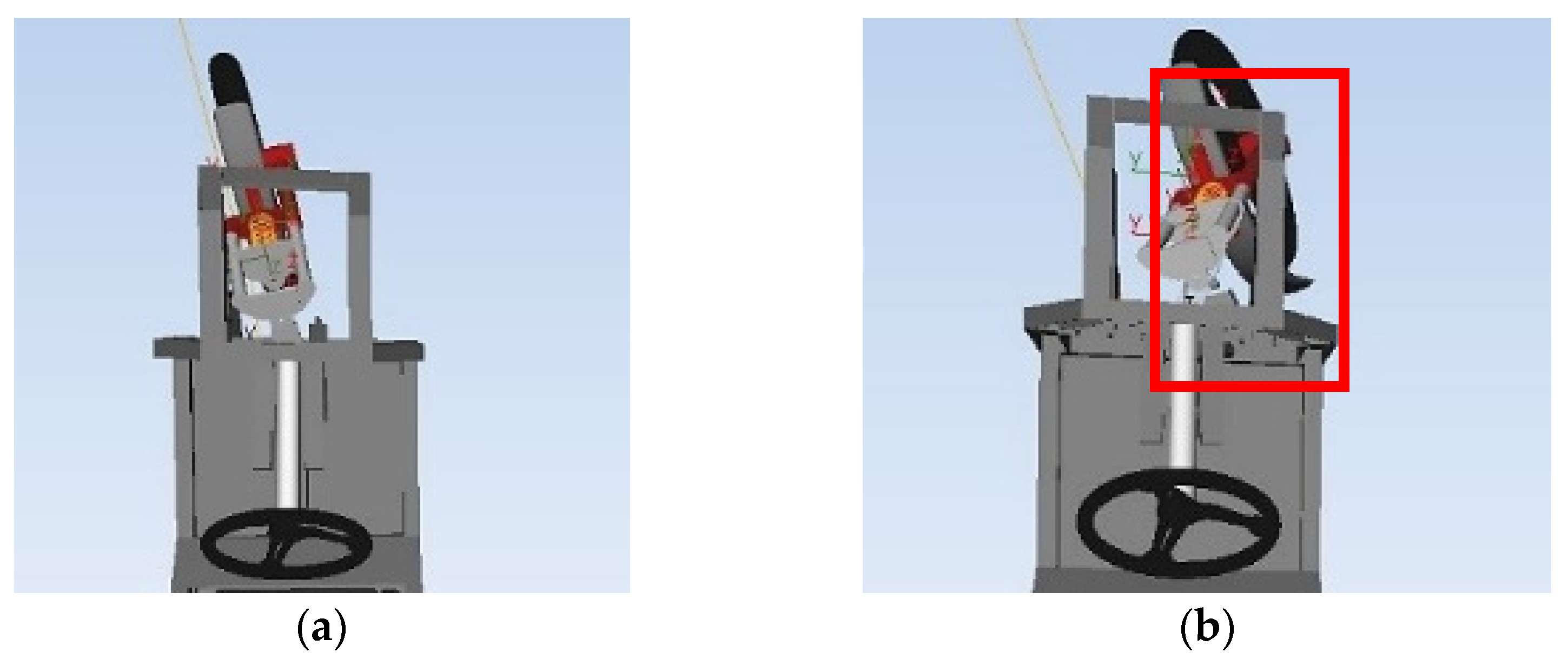



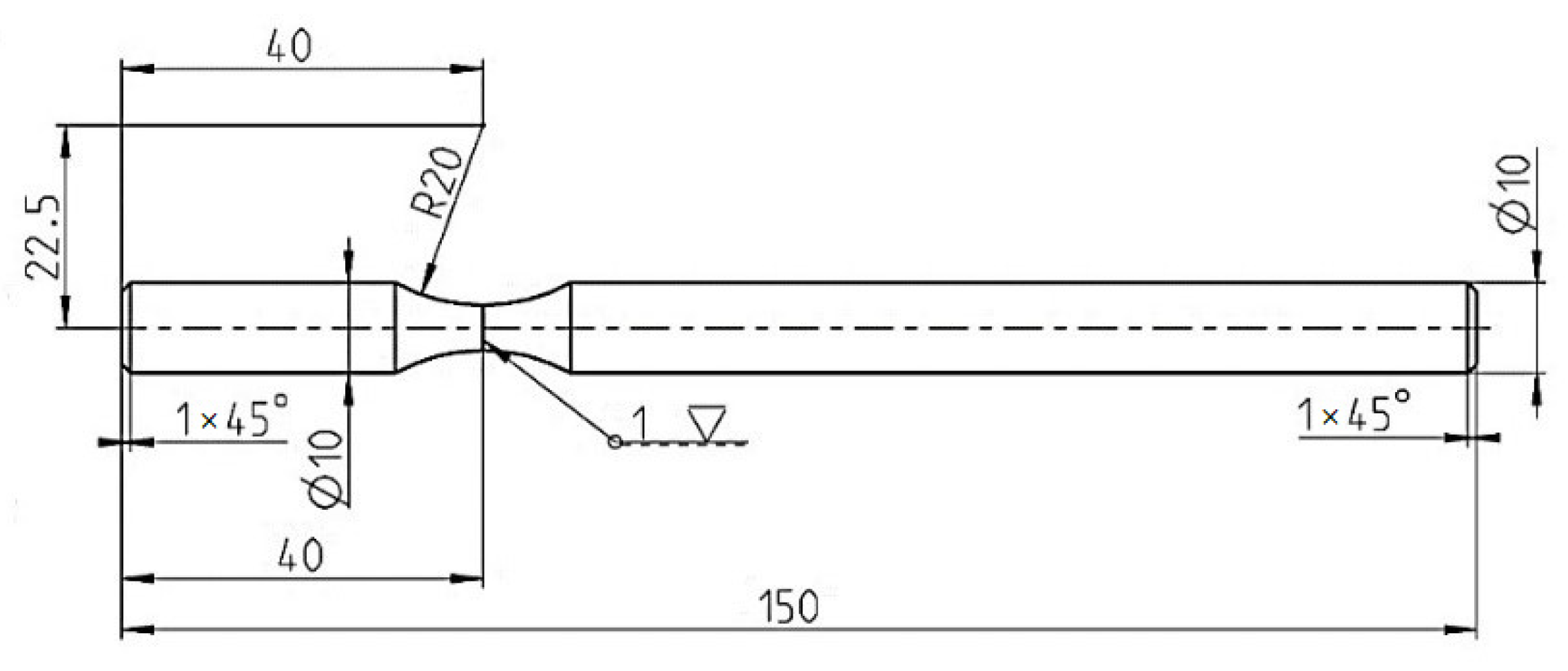
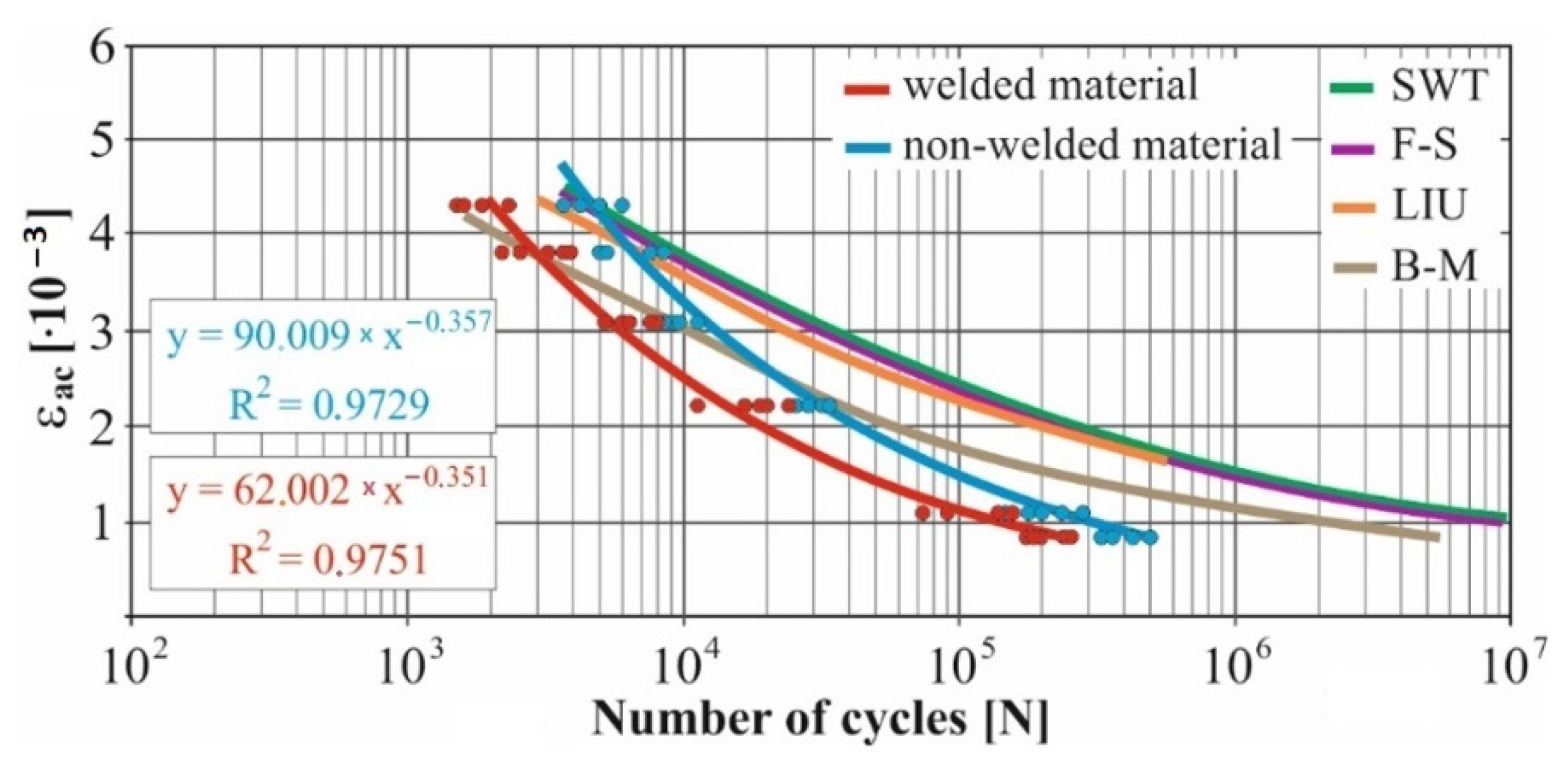
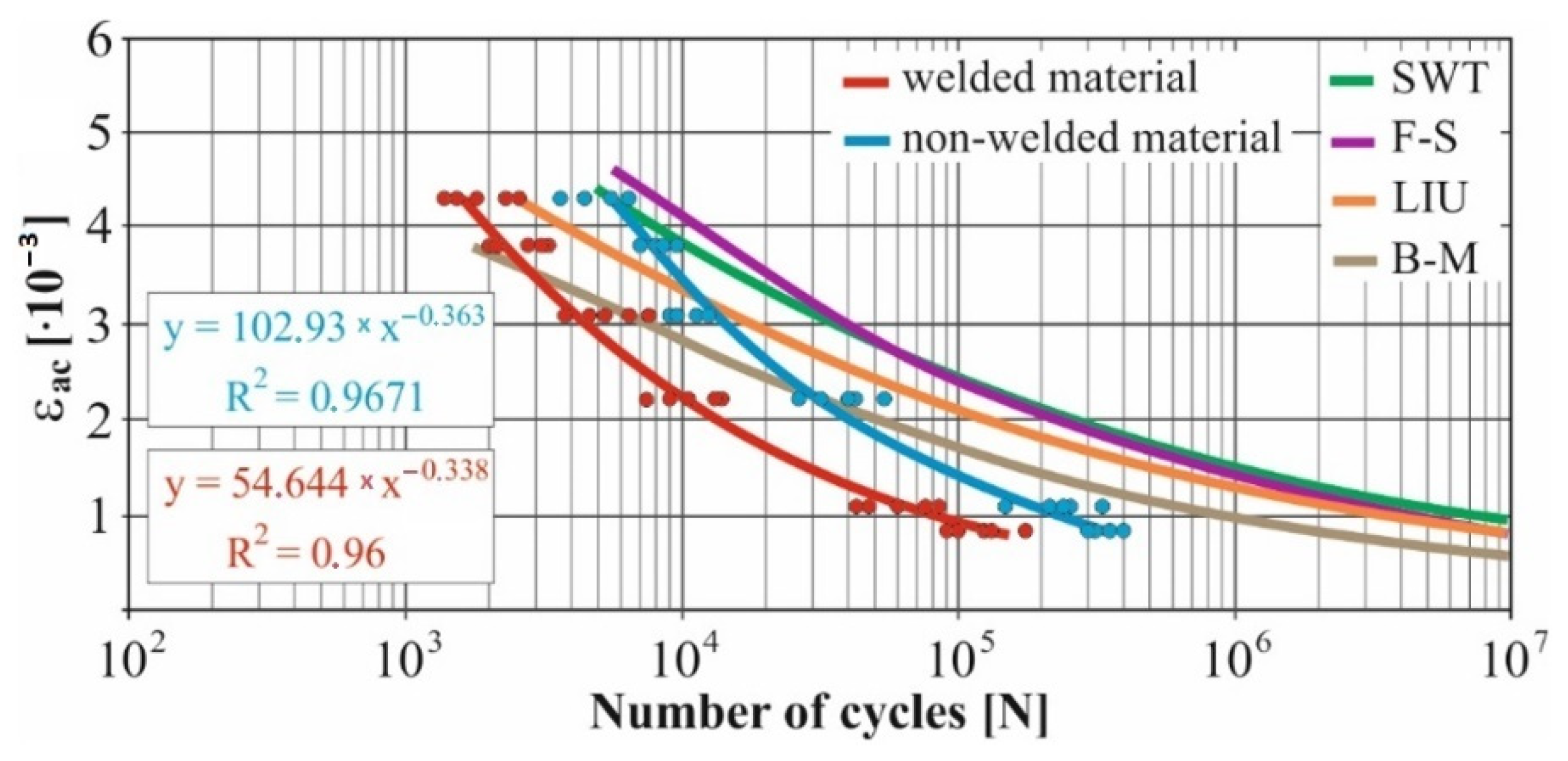
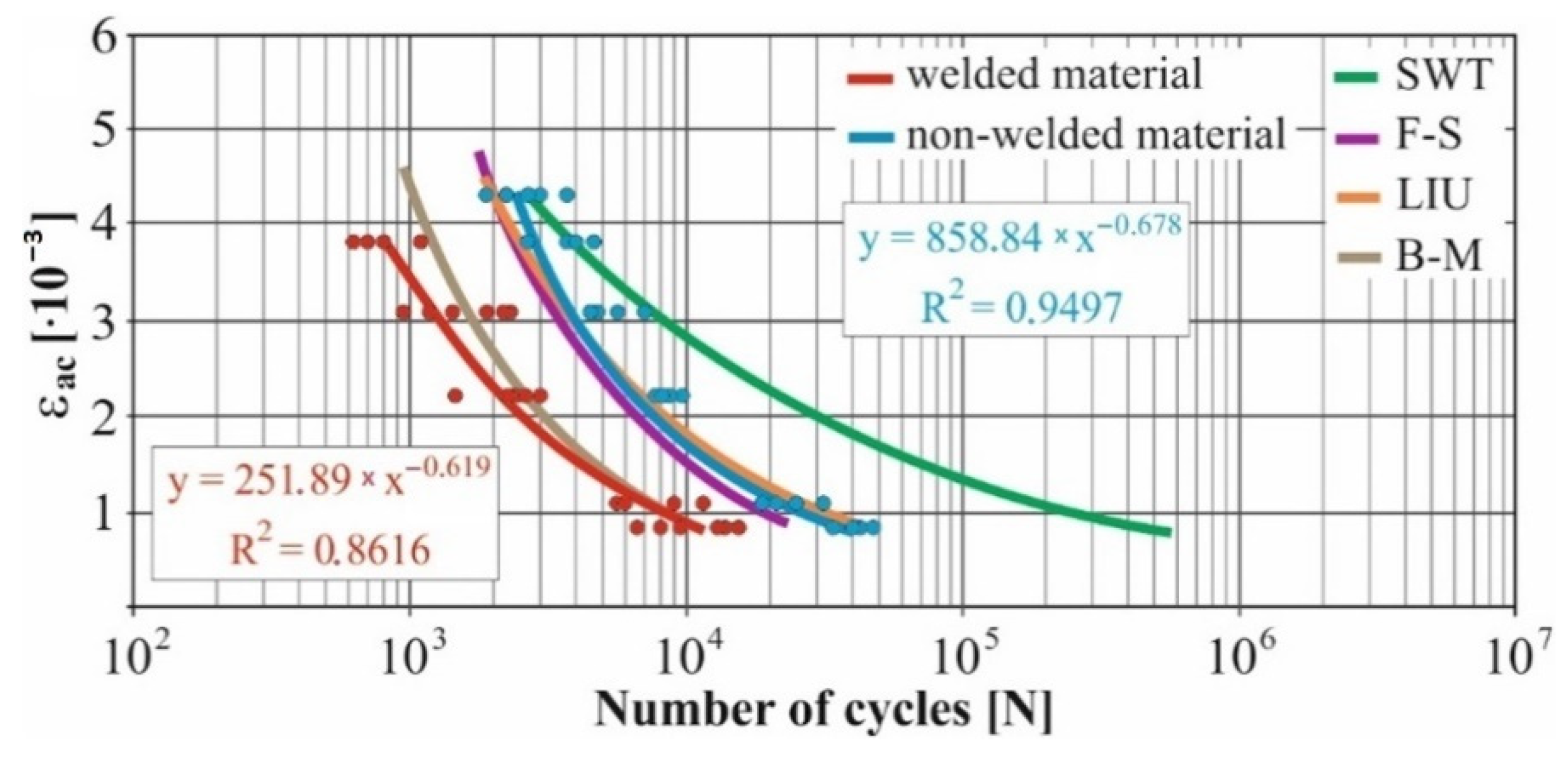
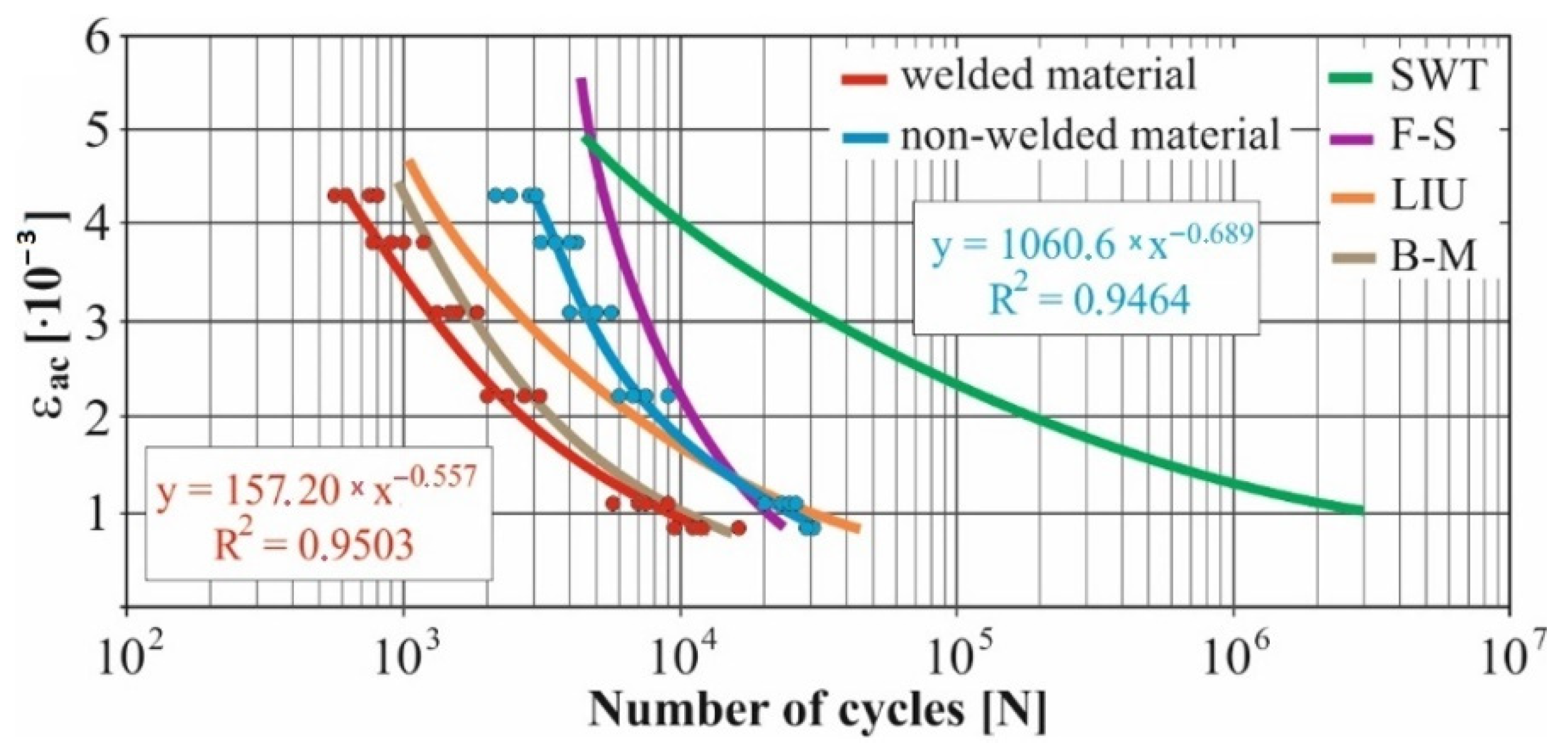
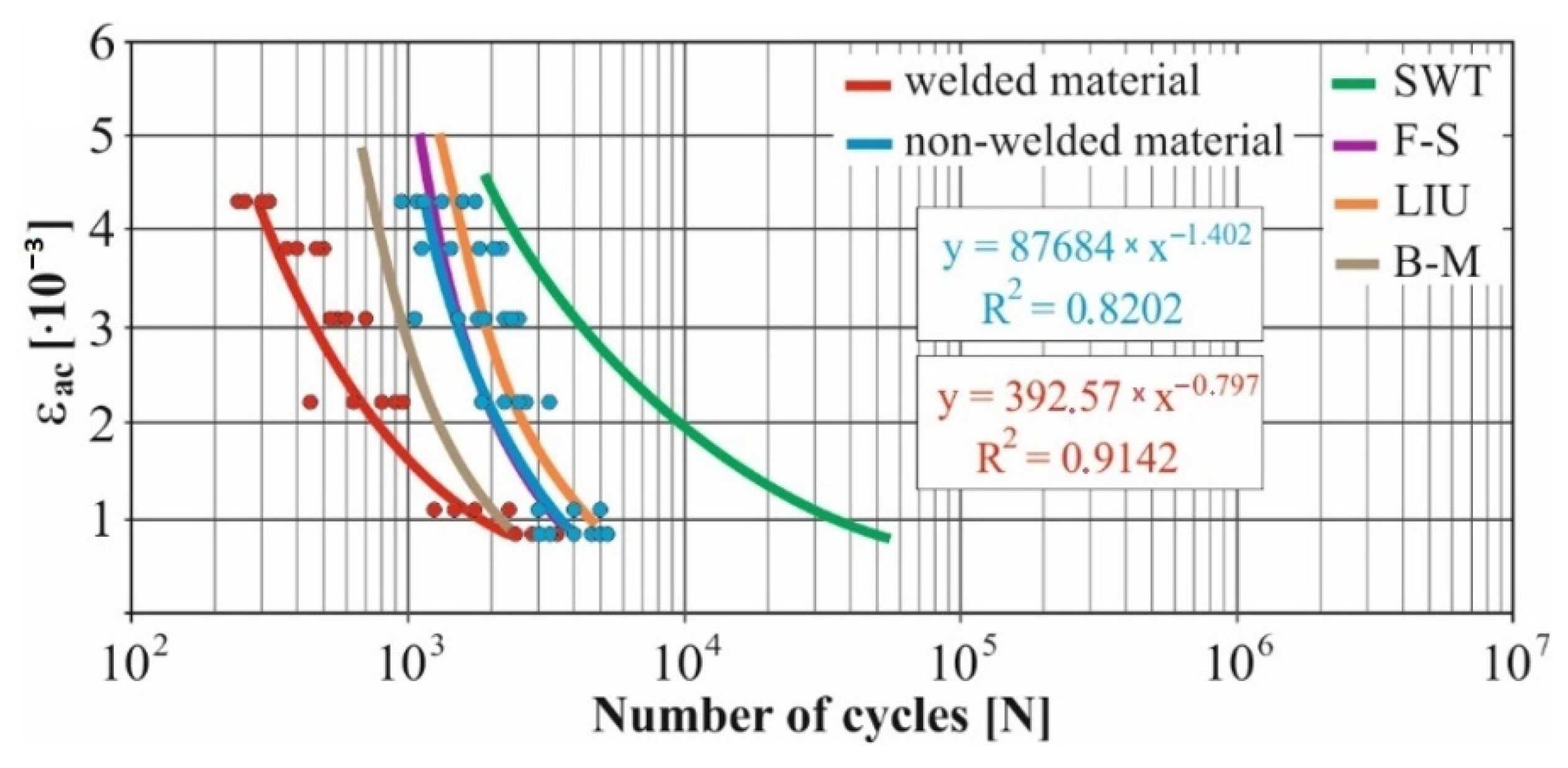
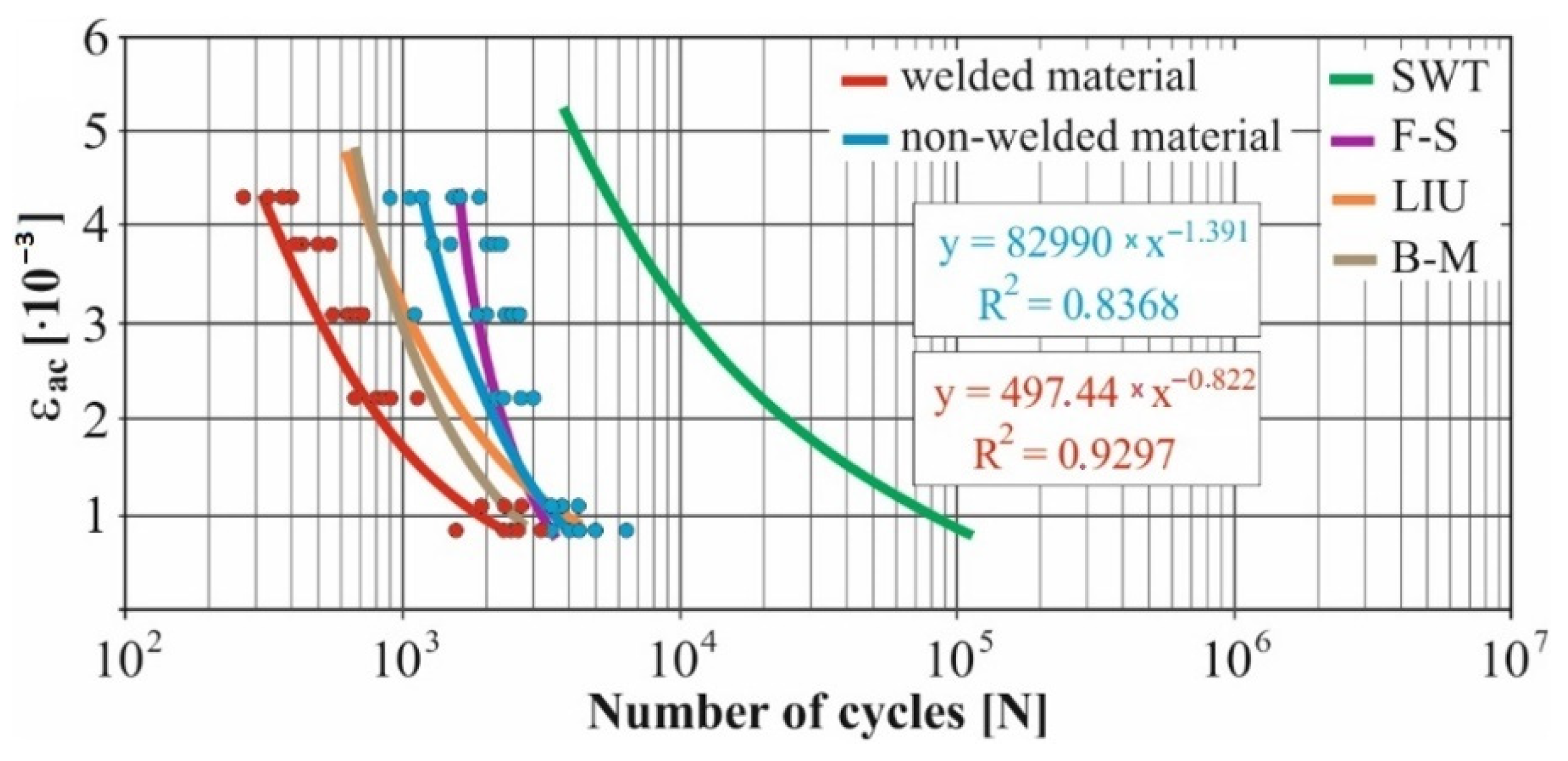
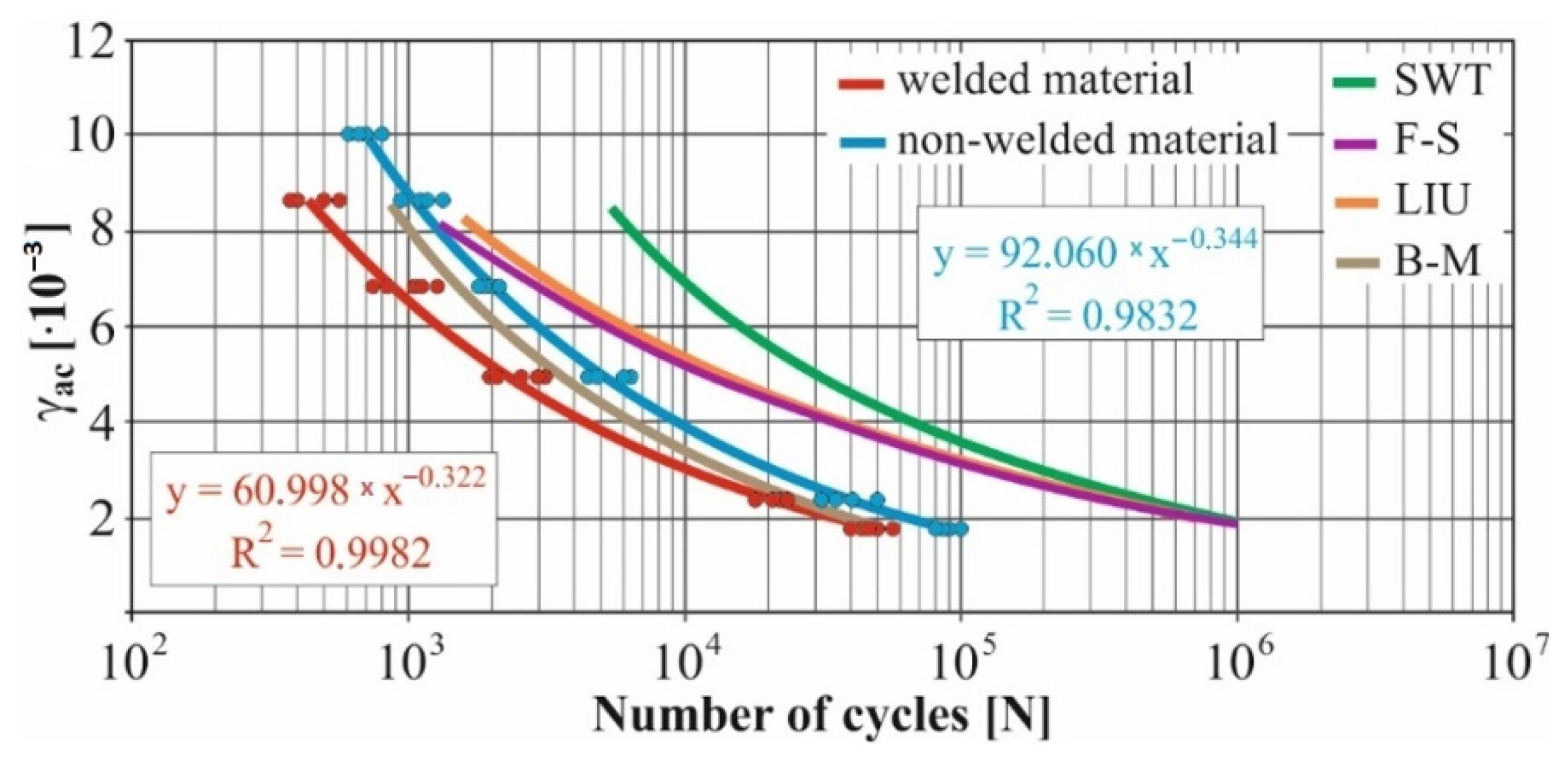


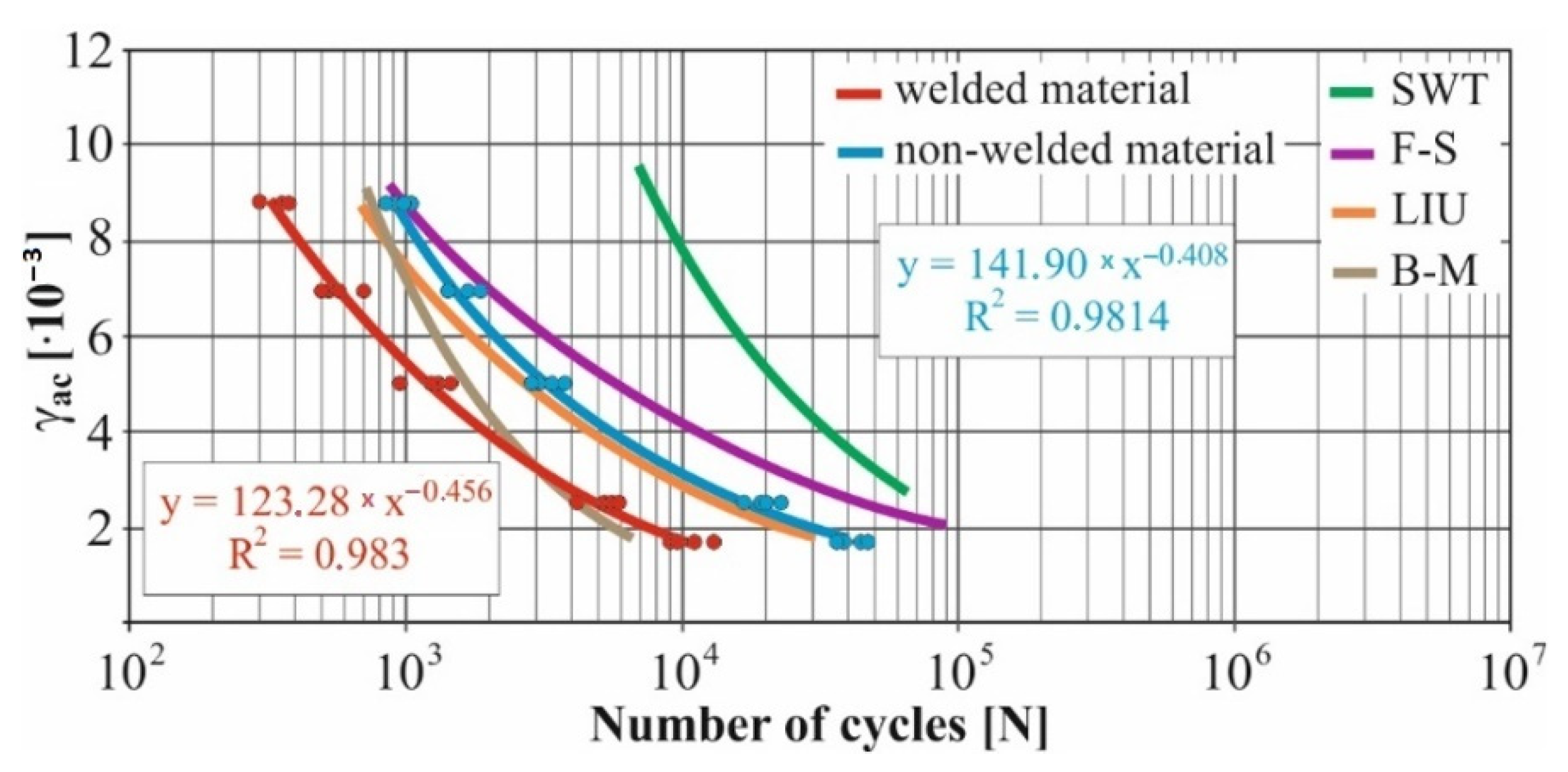
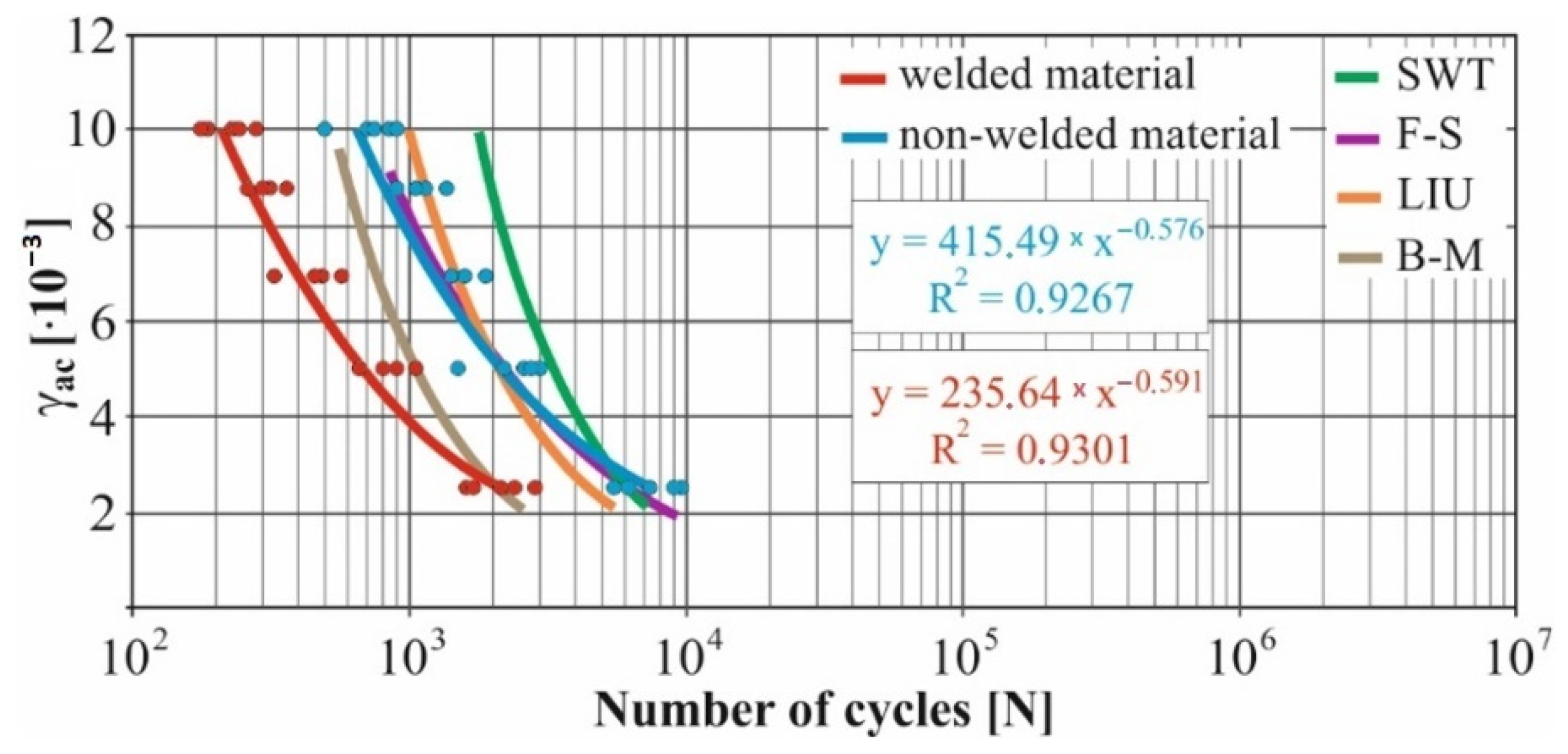


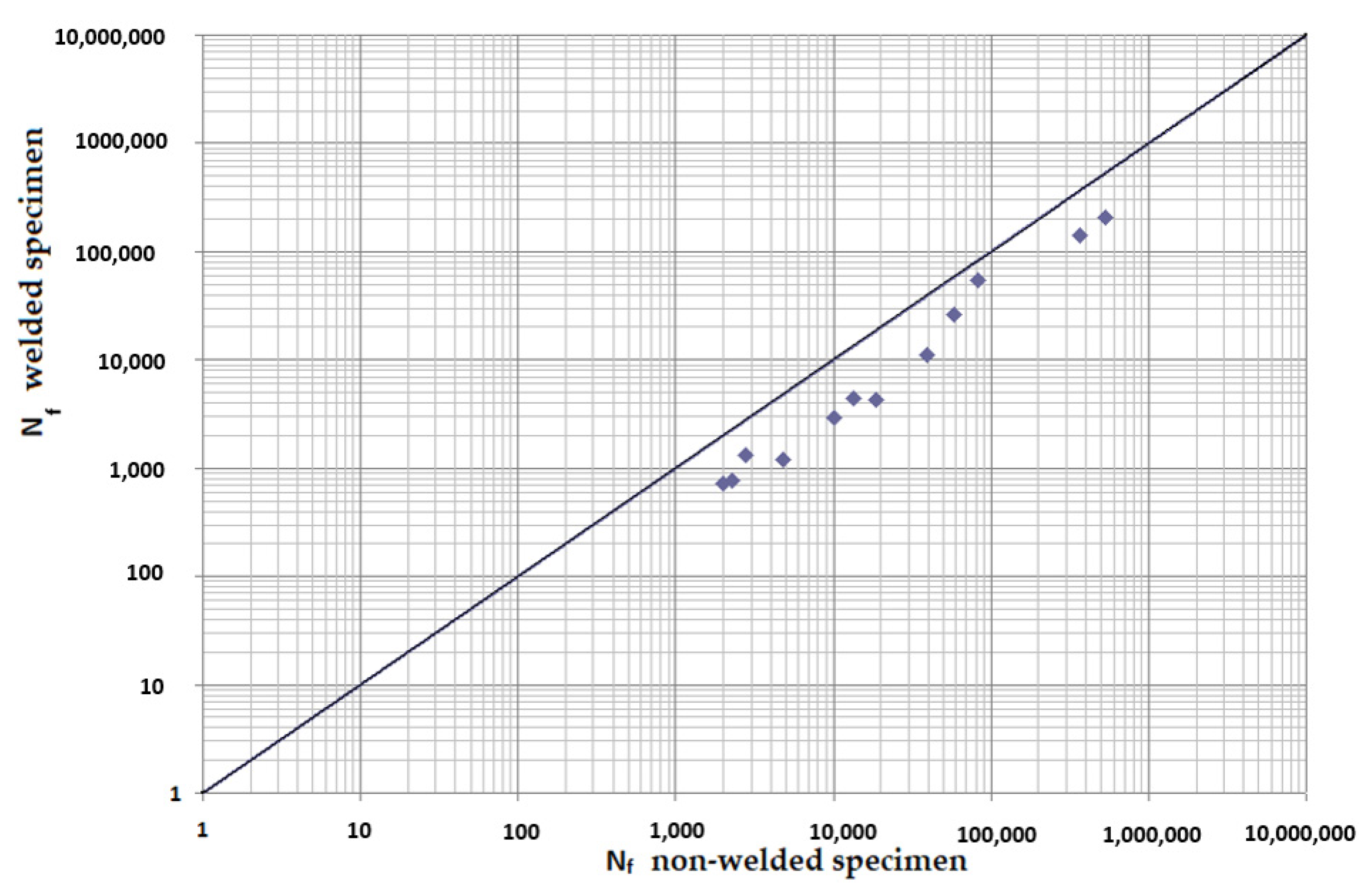
Publisher’s Note: MDPI stays neutral with regard to jurisdictional claims in published maps and institutional affiliations. |
© 2022 by the authors. Licensee MDPI, Basel, Switzerland. This article is an open access article distributed under the terms and conditions of the Creative Commons Attribution (CC BY) license (https://creativecommons.org/licenses/by/4.0/).
Share and Cite
Blatnický, M.; Dižo, J.; Sága, M.; Brůna, M.; Vaško, M. Experimental Research on Manson–Coffin Curves for the Frame Material of an Unconventional Vehicle. Materials 2022, 15, 1768. https://doi.org/10.3390/ma15051768
Blatnický M, Dižo J, Sága M, Brůna M, Vaško M. Experimental Research on Manson–Coffin Curves for the Frame Material of an Unconventional Vehicle. Materials. 2022; 15(5):1768. https://doi.org/10.3390/ma15051768
Chicago/Turabian StyleBlatnický, Miroslav, Ján Dižo, Milan Sága, Marek Brůna, and Milan Vaško. 2022. "Experimental Research on Manson–Coffin Curves for the Frame Material of an Unconventional Vehicle" Materials 15, no. 5: 1768. https://doi.org/10.3390/ma15051768






